centos 安装oracle 11g r2(一)-----软件安装
centos 安装oracle 11g r2(一)-----软件安装
1、进入管理员权限
[anzerong@localhost ~]# su - root
password
[root@localhost ~]#
2、创建用户组oinstall
[root@localhost ~]# groupadd oinstall
3、创建用户组dba
[root@localhost ~]# groupadd dba
4、创建oracle用户,并加入到oinstall和dba用户组
[root@localhost ~]# useradd -g oinstall -g dba -m oracle
5、设置用户oracle的登陆密码,不设置密码,在CentOS的图形登陆界面没法登陆
[root@localhost ~]# passwd oracle
Changing password for user oracle.
New password: # 密码
BAD PASSWORD: The password is shorter than 8 characters
Retype new password: # 再次输入密码
passwd: all authentication tokens updated successfully.
6、查看新建的oracle用户
[root@localhost ~]# id oracle
uid=1001(oracle) gid=1002(dba) groups=1002(dba)
7、进入根目录
[root@localhost ~]# cd /.
8、创建oracle数据库安装目录
[root@localhost /]# mkdir -p /data/oracle
9、创建oracle数据库配置文件目录
[root@localhost /]# mkdir -p /data/oraInventory
10、创建oracle数据库软件包解压目录
[root@localhost /]# mkdir -p /data/database
11、创建完后检查一下
[root@localhost /]# cd /data
[root@localhost data]# ls
database oracle oraInventory
12、设置目录所有者为oinstall用户组的oracle用户
[root@localhost data]# chown -R oracle:oinstall /data/oracle
[root@localhost data]# chown -R oracle:oinstall /data/oraInventory
[root@localhost data]# chown -R oracle:oinstall /data/database
13、修改OS系统标识(oracle默认不支持CentOS系统安装,但是centos与redhat的关系自行百度)
[root@localhost data]# cat /proc/version
Linux version 3.10.0-514.26.2.el7.x86_64 (builder@kbuilder.dev.centos.org) (gcc version 4.8.5 20150623 (Red Hat 4.8.5-11) (GCC) ) #1 SMP Tue Jul 4 15:04:05 UTC 2017
[root@localhost data]# cat /etc/redhat-release
CentOS Linux release 7.3.1611 (Core)
[root@localhost data]# vi /etc/redhat-release
[root@localhost data]# cat /etc/redhat-release
redhat-7
14、安装oracle数据库所需要的软件包
[root@localhost data]# yum install binutils compat-libcap1 gcc gcc-c++ glibc glibc-devel ksh libaio libaio-devel libgcc libstdc++ libstdc++-devel libXi libXtst make sysstat unixODBC unixODBC-devel glibc elfutils-libelf-devel compat*
15、查看防火墙状态(运行中)
[root@localhost data]# systemctl status firewalld.service
● firewalld.service - firewalld - dynamic firewall daemon
Loaded: loaded (/usr/lib/systemd/system/firewalld.service; enabled; vendor preset: enabled)
Active: active (running) since Wed 2017-09-13 09:23:08 CST; 25min ago
Docs: man:firewalld(1)
Main PID: 641 (firewalld)
CGroup: /system.slice/firewalld.service
└─641 /usr/bin/python -Es /usr/sbin/firewalld --nofork --nopid
Sep 13 09:22:58 localhost.localdomain systemd[1]: Starting firewalld - dynami...
Sep 13 09:23:08 localhost.localdomain systemd[1]: Started firewalld - dynamic...
Hint: Some lines were ellipsized, use -l to show in full.
16、关闭防火墙
[root@localhost data]# systemctl stop firewalld.service
17、查看防火墙状态(已关闭)
[root@localhost data]# systemctl status firewalld.service
● firewalld.service - firewalld - dynamic firewall daemon
Loaded: loaded (/usr/lib/systemd/system/firewalld.service; enabled; vendor preset: enabled)
Active: inactive (dead) since Wed 2017-09-13 09:48:55 CST; 10s ago
Docs: man:firewalld(1)
Process: 641 ExecStart=/usr/sbin/firewalld --nofork --nopid $FIREWALLD_ARGS (code=exited, status=0/SUCCESS)
Main PID: 641 (code=exited, status=0/SUCCESS)
Sep 13 09:22:58 localhost.localdomain systemd[1]: Starting firewalld - dynami...
Sep 13 09:23:08 localhost.localdomain systemd[1]: Started firewalld - dynamic...
Sep 13 09:48:54 localhost.localdomain systemd[1]: Stopping firewalld - dynami...
Sep 13 09:48:55 localhost.localdomain systemd[1]: Stopped firewalld - dynamic...
Hint: Some lines were ellipsized, use -l to show in full.
18、禁止使用防火墙(重启也是禁止的)
[root@localhost data]# systemctl disable firewalld.service
Removed symlink /etc/systemd/system/dbus-org.fedoraproject.FirewallD1.service.
Removed symlink /etc/systemd/system/basic.target.wants/firewalld.service.
19、关闭selinux(需重启生效)
[root@localhost data]# vi /etc/selinux/config
[root@localhost data]# cat /etc/selinux/config
/etc/selinux/config 最终文档为:
# This file controls the state of SELinux on the system.
# SELINUX= can take one of these three values:
# enforcing - SELinux security policy is enforced.
# permissive - SELinux prints warnings instead of enforcing.
# disabled - No SELinux policy is loaded.
SELINUX=disabled #此处修改为disabled
# SELINUXTYPE= can take one of three two values:
# targeted - Targeted processes are protected,
# minimum - Modification of targeted policy. Only selected processes are protected.
# mls - Multi Level Security protection.
SELINUXTYPE=targeted
20、修改内核参数(加入斜体部分)
[root@local++host data]# vi /etc/sysctl.conf
[root@localhost data]# cat /etc/sysctl.conf
# sysctl settings are defined through files in
# /usr/lib/sysctl.d/, /run/sysctl.d/, and /etc/sysctl.d/.
#
# Vendors settings live in /usr/lib/sysctl.d/.
# To override a whole file, create a new file with the same in
# /etc/sysctl.d/ and put new settings there. To override
# only specific settings, add a file with a lexically later
# name in /etc/sysctl.d/ and put new settings there.
#
# For more information, see sysctl.conf(5) and sysctl.d(5).
net.ipv4.icmp_echo_ignore_broadcasts = 1
net.ipv4.conf.all.rp_filter = 1
fs.file-max = 6815744 #设置最大打开文件数
fs.aio-max-nr = 1048576
kernel.shmall = 2097152 #共享内存的总量,8G内存设置:2097152*4k/1024/1024
kernel.shmmax = 2147483648 #最大共享内存的段大小
kernel.shmmni = 4096 #整个系统共享内存端的最大数
kernel.sem = 250 32000 100 128
net.ipv4.ip_local_port_range = 9000 65500 #可使用的IPv4端口范围
net.core.rmem_default = 262144
net.core.rmem_max= 4194304
net.core.wmem_default= 262144
net.core.wmem_max= 1048576
21、使配置修改内核的参数生效
[root@localhost data]# sysctl -p
net.ipv4.icmp_echo_ignore_broadcasts = 1
net.ipv4.conf.all.rp_filter = 1
sysctl: setting key "fs.file-max": Invalid argument
fs.file-max = 6815744 #设置最大打开文件数
fs.aio-max-nr = 1048576
sysctl: setting key "kernel.shmall": Invalid argument
kernel.shmall = 2097152 #共享内存的总量,8G内存设置:2097152*4k/1024/1024
sysctl: setting key "kernel.shmmax": Invalid argument
kernel.shmmax = 2147483648 #最大共享内存的段大小
sysctl: setting key "kernel.shmmni": Invalid argument
kernel.shmmni = 4096 #整个系统共享内存端的最大数
kernel.sem = 250 32000 100 128
sysctl: setting key "net.ipv4.ip_local_port_range": Invalid argument
net.ipv4.ip_local_port_range = 9000 65500 #可使用的IPv4端口范围
net.core.rmem_default = 262144
net.core.rmem_max = 4194304
net.core.wmem_default = 262144
net.core.wmem_max = 1048576
22、对oracle用户设置限制,提高软件运行性能(斜体为添加部分)
[root@localhost data]# vi /etc/security/limits.conf
[root@localhost data]# cat /etc/security/limits.conf
# /etc/security/limits.conf
#
#This file sets the resource limits for the users logged in via PAM.
#It does not affect resource limits of the system services.
#
#Also note that configuration files in /etc/security/limits.d directory,
#which are read in alphabetical order, override the settings in this
#file in case the domain is the same or more specific.
#That means for example that setting a limit for wildcard domain here
#can be overriden with a wildcard setting in a config file in the
#subdirectory, but a user specific setting here can be overriden only
#with a user specific setting in the subdirectory.
#
#Each line describes a limit for a user in the form:
#
#
#
#Where:
# can be:
# - a user name
# - a group name, with @group syntax
# - the wildcard *, for default entry
# - the wildcard %, can be also used with %group syntax,
# for maxlogin limit
#
# can have the two values:
# - "soft" for enforcing the soft limits
# - "hard" for enforcing hard limits
#
# can be one of the following:
# - core - limits the core file size (KB)
# - data - max data size (KB)
# - fsize - maximum filesize (KB)
# - memlock - max locked-in-memory address space (KB)
# - nofile - max number of open file descriptors
# - rss - max resident set size (KB)
# - stack - max stack size (KB)
# - cpu - max CPU time (MIN)
# - nproc - max number of processes
# - as - address space limit (KB)
# - maxlogins - max number of logins for this user
# - maxsyslogins - max number of logins on the system
# - priority - the priority to run user process with
# - locks - max number of file locks the user can hold
# - sigpending - max number of pending signals
# - msgqueue - max memory used by POSIX message queues (bytes)
# - nice - max nice priority allowed to raise to values: [-20, 19]
# - rtprio - max realtime priority
#
#
##* soft core 0
#* hard rss 10000
#@student hard nproc 20
#@faculty soft nproc 20
#@faculty hard nproc 50
#ftp hard nproc 0
#@student - maxlogins 4oracle soft nproc 2047
oracle hard nproc 16384
oracle soft nofile 1024
oracle hard nofile 65536# End of file
23、配置用户的环境变量(斜体部分为添加代码)
[root@localhost data]# vi /home/oracle/.bash_profile
[root@localhost data]# cat /home/oracle/.bash_profile
# .bash_profile
# Get the aliases and functions
if [ -f ~/.bashrc ]; then
. ~/.bashrc
fi# User specific environment and startup programs
PATH=$PATH:$HOME/.local/bin:$HOME/bin
export PATH
export ORACLE_BASE=/data/oracle #oracle数据库安装目录
export ORACLE_HOME=$ORACLE_BASE/product/11.2.0/db_1 #oracle数据库路径
export ORACLE_SID=orcl #oracle启动数据库实例名
export ORACLE_TERM=xterm #xterm窗口模式安装
export PATH=$ORACLE_HOME/bin:/usr/sbin:$PATH #添加系统环境变量
export LD_LIBRARY_PATH=$ORACLE_HOME/lib:/lib:/usr/lib #添加系统环境变量
export LANG=C #防止安装过程出现乱码
export NLS_LANG=AMERICAN_AMERICA.ZHS16GBK #设置Oracle客户端字符集,必须与Oracle安装时设置的字符集保持一致
24、使用户的环境变量配置立即生效
[root@localhost data]# source /home/oracle/.bash_profile
25、将安装包移动到/usr/local/src路径下
[root@localhost ~]# cd /.
[root@localhost /]# cd /home/anzerong/Desktop/
[root@localhost Desktop]# ls
linux.x64_11gR2_database_1of2.zip linux.x64_11gR2_database_2of2.zip
[root@localhost Desktop]# mv linux.x64_11gR2_database_1of2.zip /usr/local/src
[root@localhost Desktop]# ls
linux.x64_11gR2_database_2of2.zip
[root@localhost Desktop]# mv linux.x64_11gR2_database_2of2.zip /usr/local/src
26、重启系统,确保所有设置生效
[root@localhost Desktop]# reboot
27、从oracle用户进入/usr/local/src目录
[oracle@localhost /]$ cd /usr/local/src
[oracle@localhost src]$ ls
linux.x64_11gR2_database_1of2.zip linux.x64_11gR2_database_2of2.zip
28、解压两个软件包至/data/database/目录下
[oracle@localhost src]$ unzip linux.x64_11gR2_database_1of2.zip -d /data/database/ #解压
(省略...)
[oracle@localhost src]$ unzip linux.x64_11gR2_database_2of2.zip -d /data/database/ #解压
(省略...)
29、进入管理员权限
[oracle@localhost src]$ su root
Password:
30、设置目录所有者为oinstall用户组的oracle用户
[root@localhost src]# chown -R oracle:oinstall /data/database/database/
31、执行安装脚本
[oracle@localhost /]$ cd /data/database/database/
[oracle@localhost database]$ ls
doc install response rpm runInstaller sshsetup stage welcome.html
[oracle@localhost database]$ ./runInstaller
Starting Oracle Universal Installer...
(省略...)
oracle图形化安装界面打开
32、++Configure Security Updates++
去掉 I wish to receive security updates via My Oracle Support.
点击 “Nest >”
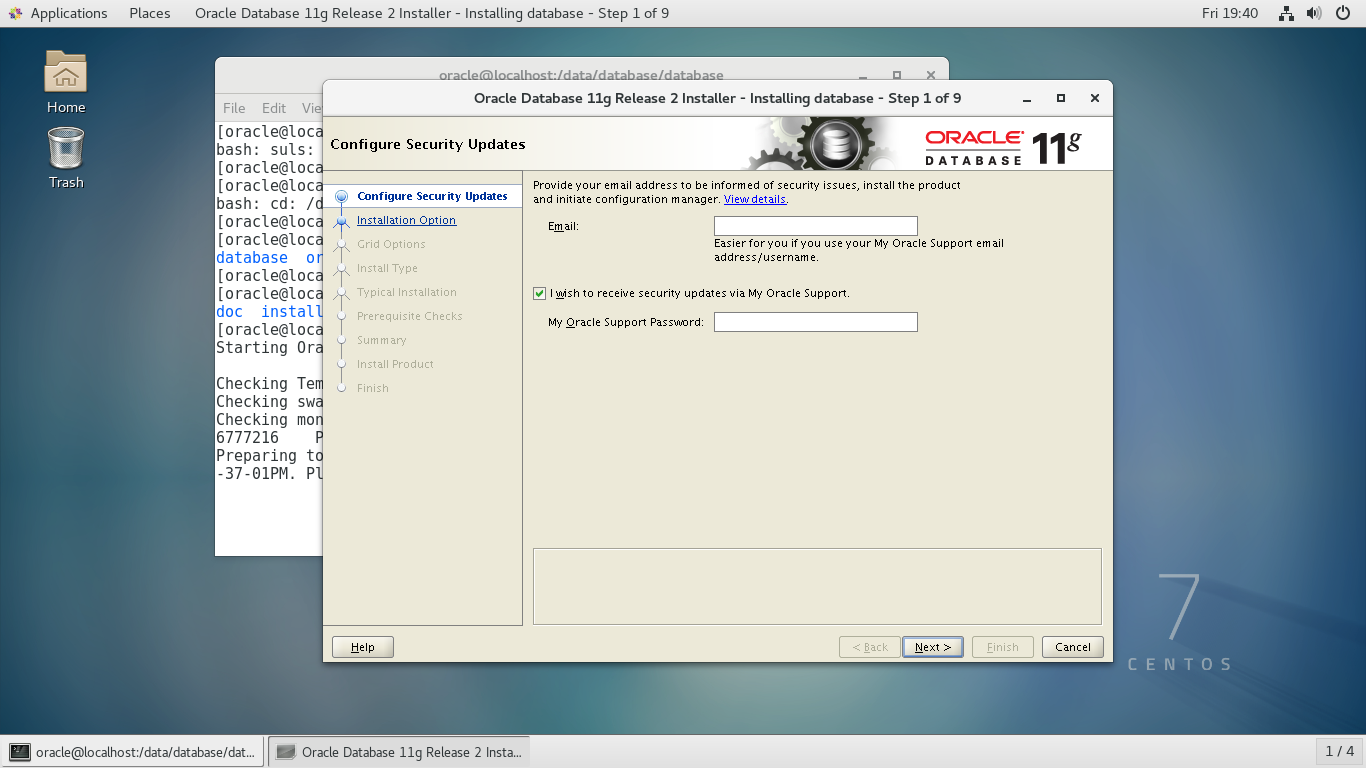

33、++Installation Option++
选择第二项 Install database software only
点击 “Nest >”

34、++Grid Options++
选择单例模式 Single instance database installation
点击 “Nest >”

35、++Product Languages++
选择英语 English(根据系统默认选择好了)
点击 “Nest >”
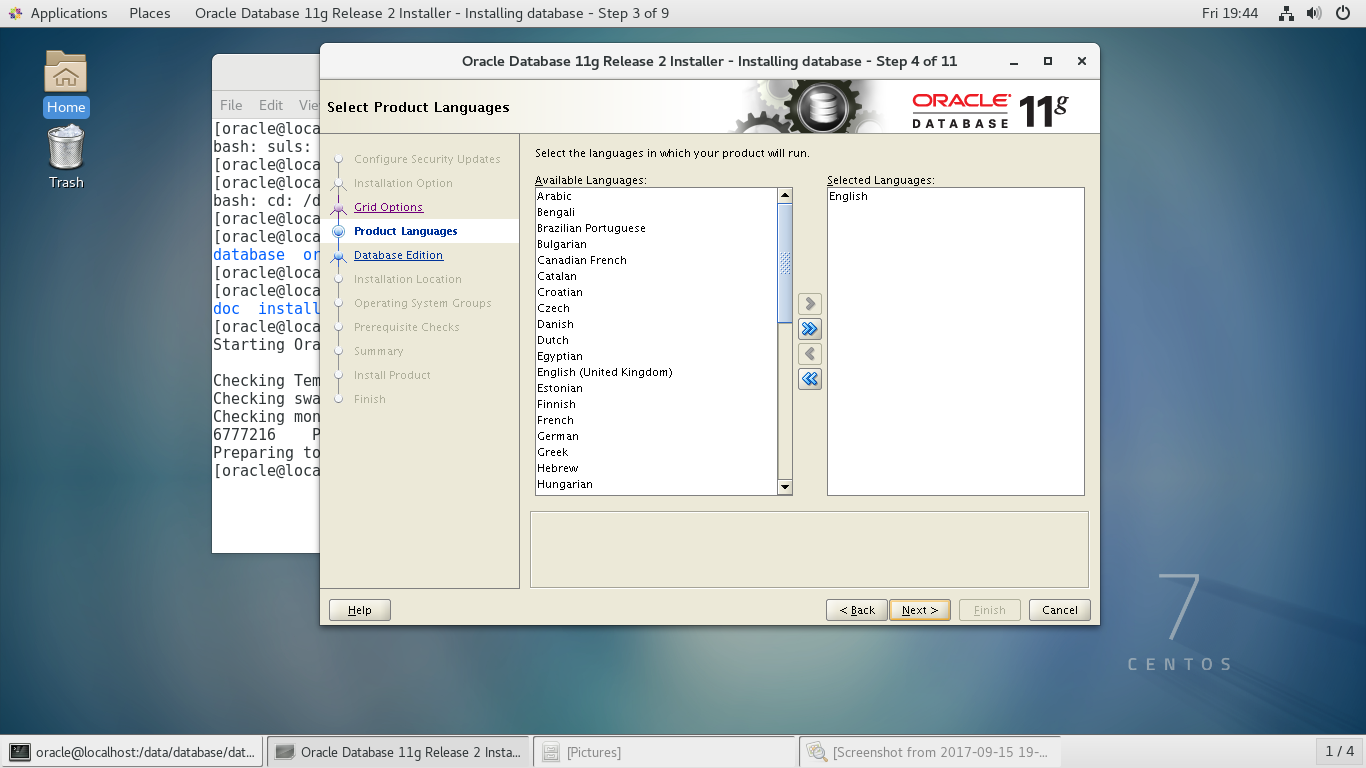
36、++Database Edition++
选择第一个企业版
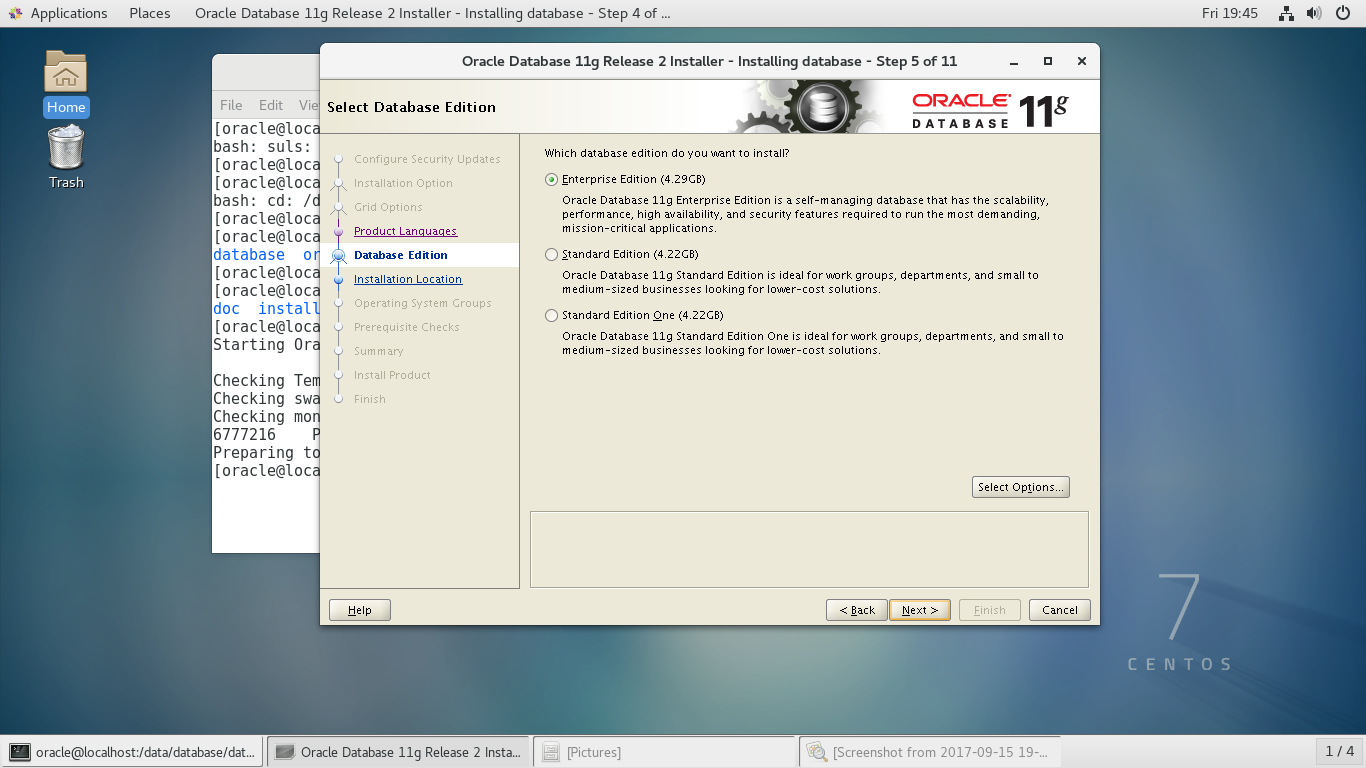
37、++Installation Location++
确定数据软件的安装路径,自动读取前面Oracle环境变量中配置的值
点击 “Nest >”

38、++Create Inventory++
选择默认,不做修改
点击 “Nest >”

39、++Operation System Groups++
全部使用dba用户组
点击 “Nest >”

40、++Prepequisite Checks++
按照提示信息一个一个解决
点击 “Nest >”


PS:pdksh安装
1、卸载已安装的ksh
[root@localhost Desktop]# rpm -e pdksh*
[root@localhost Desktop]# rpm -e ksh*
2、下载pdksh-5.2.14-21.x86_64.rpm
3、安装
[root@localhost Desktop]# rpm -ivh pdksh-5.2.14-21.x86_64.rpm --force --nodeps
按提示解决缺少的依赖包,之后点击 “Check Again”
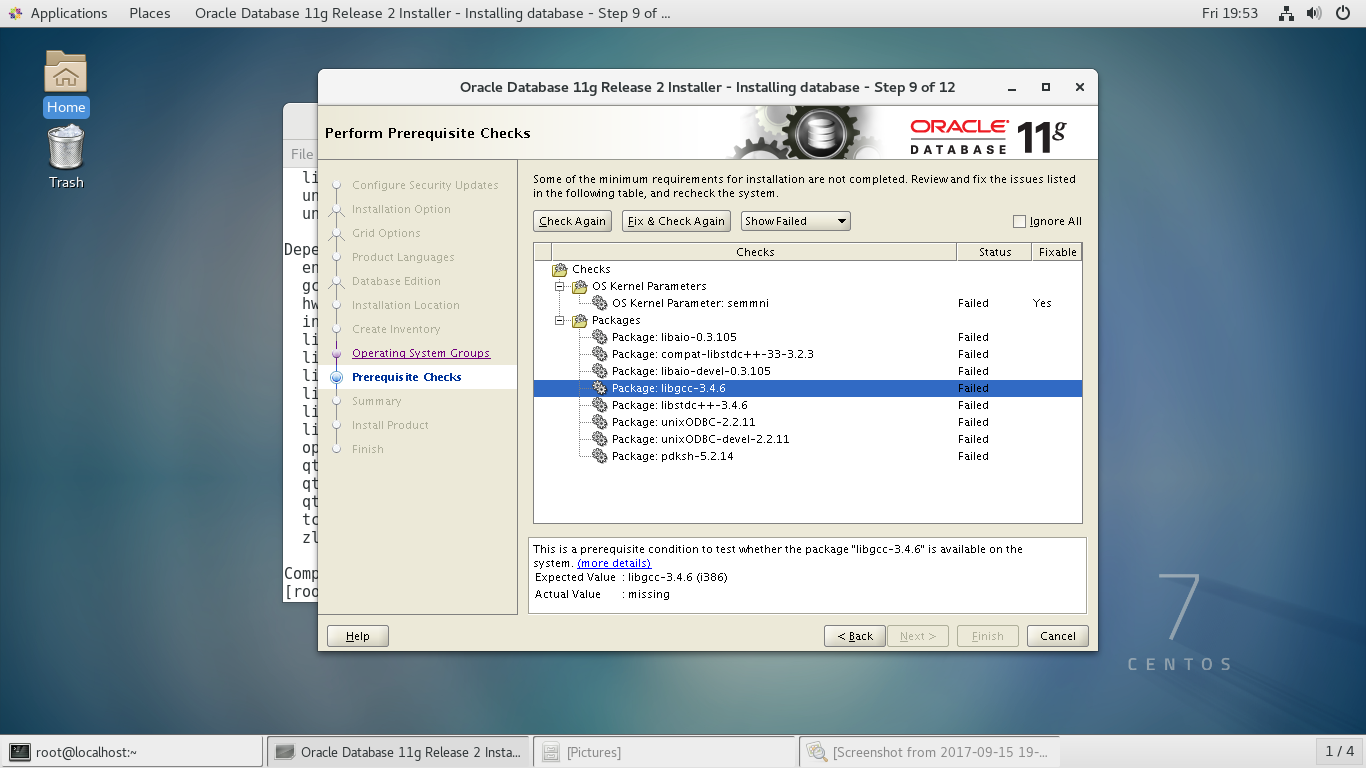
可以忽略缺少的32bit依赖包

41、++Summary++
点击 “Finsh”
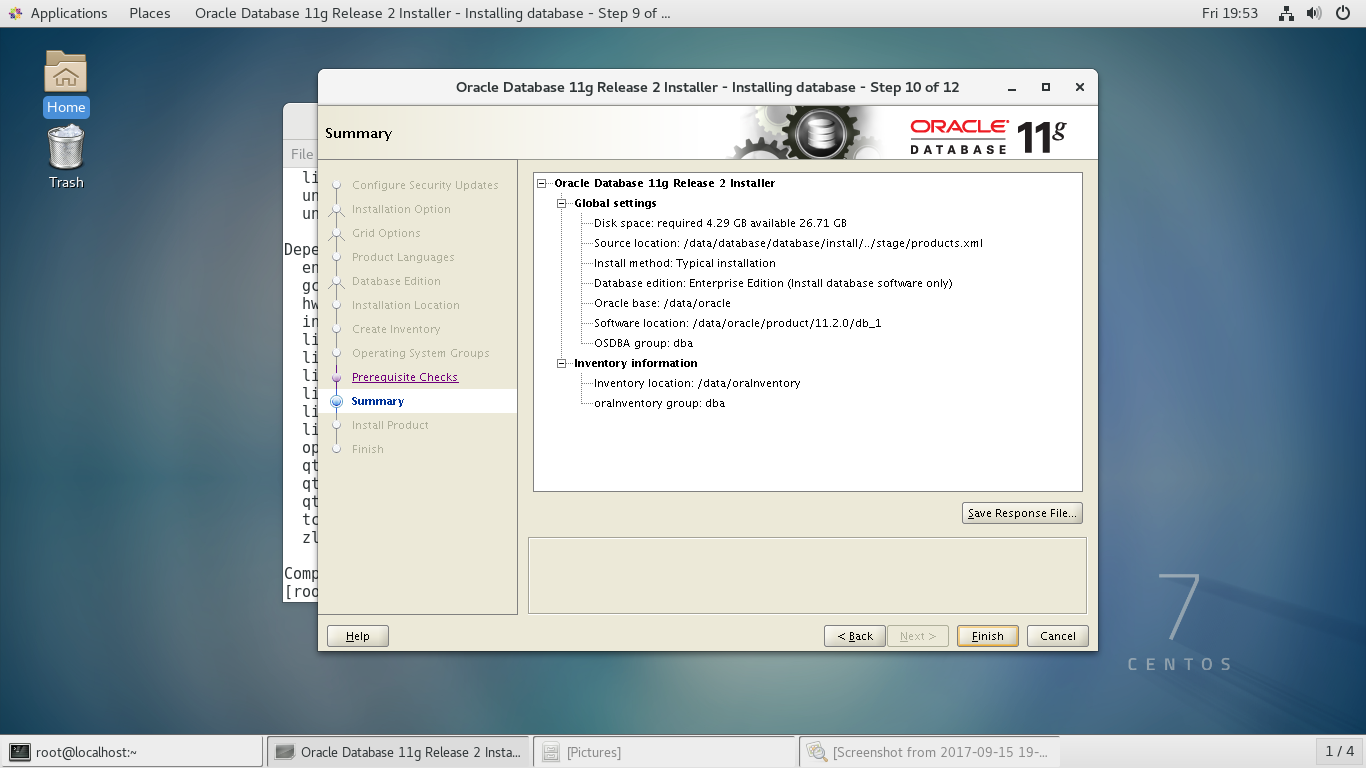
42、++Install Product++
在此过程中,安装界面会变成黑色,有一长条出现(其实是一个提示框),调整高度与宽度查看,
或者可以直接右键选择close
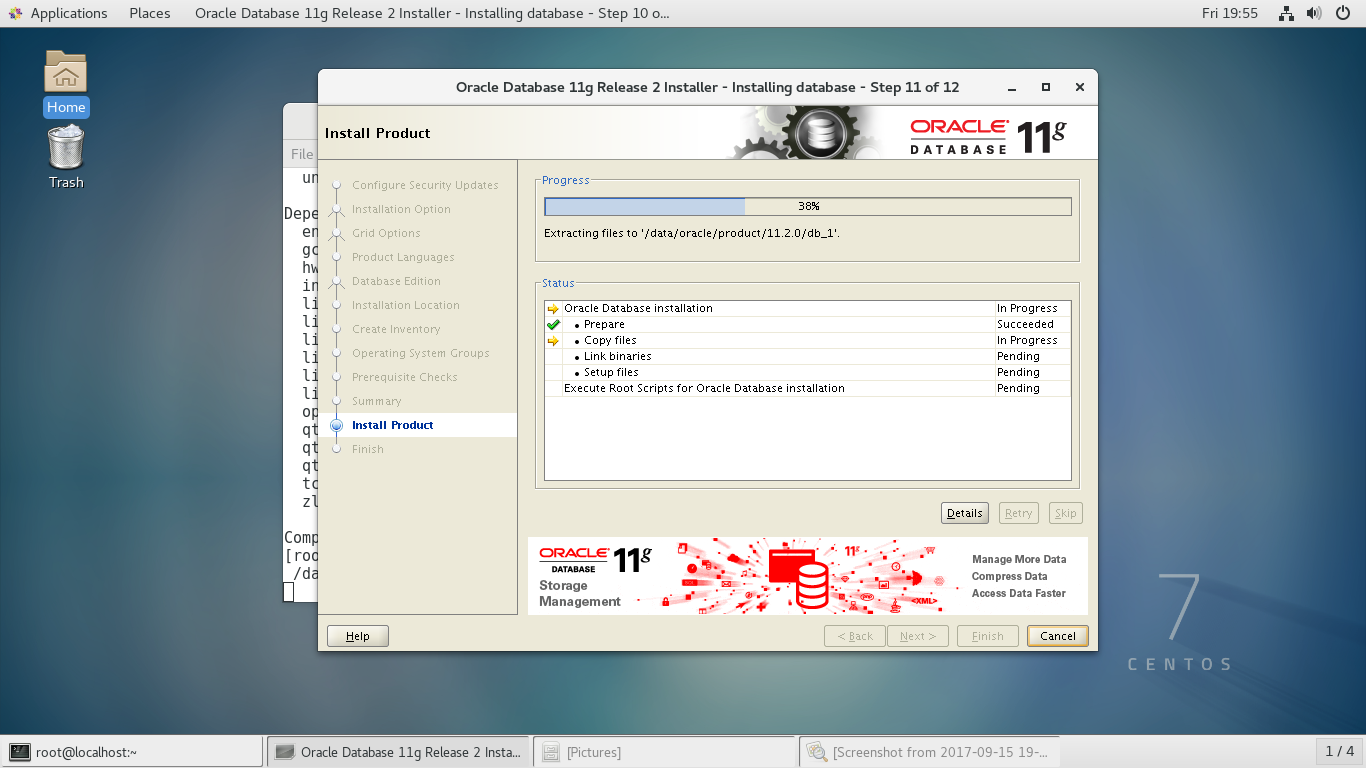

43、++Finish++
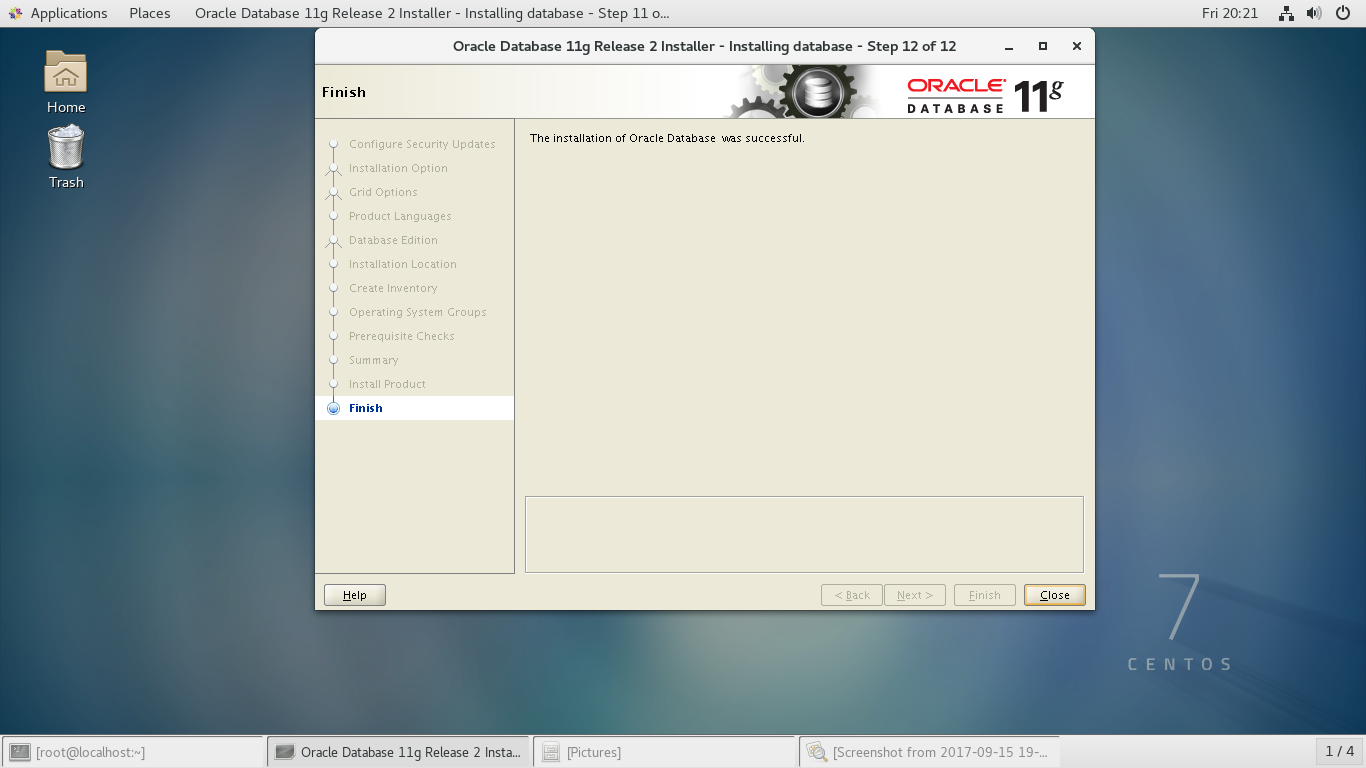
参考:http://www.linuxidc.com/Linux/2016-04/130559.htm
centos 安装oracle 11g r2(二)-----监听配置与创建数据库实例
http://www.cnblogs.com/anzerong2012/p/7940850.html
centos 安装oracle 11g r2(三)-----表空间创建
http://www.cnblogs.com/anzerong2012/p/7941179.html
centos 安装oracle 11g r2(一)-----软件安装的更多相关文章
- CentOS 7静默安装Oracle 11g R2数据库软件
之前安装Oracle 11g R2数据库软件都是建立在图形界面上的,不过现在大部分服务器上都没有安装图形界面.图形界面安装较为方便,安装选项清晰,步骤明确,但Oracle还支持另一种安装方式,就是通过 ...
- CentOS5.5 正式开始安装 Oracle 11g r2(图形界面安装)
一.下载oracle 官方网站, 可以下载最新版本 Oracle Database 11g Release http://www.oracle.com/index.html CentOS5. i386 ...
- Oracle 11g R2 Sample Schemas 安装
最近准备对之前学习SQL*Loader的笔记进行整理,希望通过官方文档中的示例学习(Case Studies)来进行,但是官方文档中示例学习相关的脚本文件在数据库软件安装完成之后默认并没有提供,而是整 ...
- centos 安装oracle 11g r2(三)-----表空间创建
centos 安装oracle 11g r2(三)-----表空间创建 创建表空间前要保证监听与数据库实例已经启动 1.启动监听 [oracle@localhost ~]$ lsnrctl start ...
- centos 安装oracle 11g r2(二)-----监听配置与创建数据库实例
centos 安装oracle 11g r2(二)-----监听配置与创建数据库实例 一.监听配置(命令:netca) 1.以 oracle 用户输入命令,启动图形化工具配置监听 [oracle@lo ...
- CentOS 安装Oracle 11g R2
CentOS 安装Oracle 11g R2 学习了-/ https://www.osyunwei.com/archives/5445.html
- Redhat Linux 下安装Oracle 11g R2
能够下载:http://download.csdn.net/detail/ykh554541184/8086647文档方便查阅 官方文档:http://docs.oracle.com/cd/E1188 ...
- Oracle Linux 6.3下安装Oracle 11g R2(11.2.0.3)
本文主要描写叙述了在Oracle Linux 6.3下安装Oracle 11gR2(11.2.0.3).从Oracle 11g開始,Oracle官方站点不再提供其Patch的下载链接,须要使用Meat ...
- Linux x64系统上安装 oracle 11g R2 x64
1.首先到官网上下载oracle 11g x64位软件包 下载地址: http://download.oracle.com/otn/linux/oracle11g/R2/linux.x64_11gR2 ...
随机推荐
- 学习ApiCloud遇到的问题
1,当前账户xx 似乎没有权限访问此应用的云端数据,请切换账 检查项目的config.xml的id与apicloud的应用id是否一致
- C# 重启程序本身
private static void Restart() { Thread thtmp = new Thread(new ParameterizedThreadStart(run)); object ...
- 利用Solr服务建立的站内搜索雏形
最近看完nutch后总感觉像好好捯饬下solr,上次看到老大给我展现了下站内搜索我便久久不能忘怀.总觉着之前搭建的nutch配上solr还是有点呆板,在nutch爬取的时候就建立索引到solr服务下, ...
- Html5 postMessage实现跨域消息传递
一.同源策略 要理解跨域,我们首先要知道什么是同源策略.百度百科上这样定义同源策略:同源策略(Same origin policy)是一种约定,它是浏览器最核心也最基本的安全功能,如果缺少了同源策略, ...
- python单元测试模块unittest
1.unittest_demo.py # coding=utf-8 import time import unittest from HtmlTestRunner import HTMLTestRun ...
- angularJs中的checkboxs
<!DOCTYPE html><html> <head> <meta charset="UTF-8"> <title>& ...
- C++ 继承与派生
继承的意义? 使程序的设计更符合发展规律,即事物的发展是一个从低级到高级的发展过程,类的继承也是反映由原始的简单代码到丰富的高级代码的过程.它能帮助我们描述事物的层次关系,有效而精确的理解事物,理解事 ...
- Eclipse中修改包名,提交SVN时报 is out of date,怎么办?
问题:Eclipse中修改包名,提交SVN时报 is out of date,怎么办?描述: Hi,大家好! 我的问题如题,在不考虑用TortoiseSVN客户端直接删除目录这个方法的情况下,有什么方 ...
- scrollview滑动到某区域执行某种方法
在这里通过 offset.y 检测滑动到的区域 通过if 语句执行需要的方法 -(void)scrollViewDidScroll:(UIScrollView *)scrollView { ...
- CocosCreator原生平台退出游戏,暂停和继续
原生平台退出游戏,方法为:cc.director.end();官方解释:End the life of director in the next frame暂停游戏,方法: cc.director.p ...
